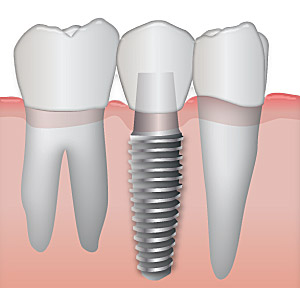 A dental implant is an appliance used to replace the roots of teeth. The implant is surgically attached to the jaw bone and an artificial tooth is attached to the top of the implant, creating a natural looking, undetectable replacement for the missing tooth. In the event that more than one tooth is missing, several implants may provide a base for a series of artificial teeth known as a fixed bridge. Implants can even be used to secure a full set of removable dentures for people who have no remaining natural teeth. This can greatly improve chewing ability and reduce the risk of choking.
A dental implant is an appliance used to replace the roots of teeth. The implant is surgically attached to the jaw bone and an artificial tooth is attached to the top of the implant, creating a natural looking, undetectable replacement for the missing tooth. In the event that more than one tooth is missing, several implants may provide a base for a series of artificial teeth known as a fixed bridge. Implants can even be used to secure a full set of removable dentures for people who have no remaining natural teeth. This can greatly improve chewing ability and reduce the risk of choking.
It generally takes about six months to a year for the surgical implant to heal before the final installation of the artificial tooth or teeth can be finished.
What are the Advantages of Dental Implants?
Dental implants with artificial teeth are the closest thing to regrowing your natural teeth. They are strong, stable, durable and virtually undetectable. By filling gaps left by missing teeth, implants can provide better chewing ability and head off jaw joint problems. They are far superior to removable dentures.
Are Dental Implants Right for Me?
Dental implants are excellent, state-of-the-art restorations and have few disadvantages when compared to alternatives such as dentures. However, dental implants do require surgery and time to heal, and they are initially more expensive than dentures or fixed bridges. These disadvantages are offset by the ease of use, saved time and long term health benefits of implants.
Single Tooth Implants
Single tooth implants are an excellent way to replace a single missing tooth. Because implants act as an artificial root for a false tooth or crown, they function almost exactly like a natural tooth. It is very important to replace missing teeth, because missing teeth leads to bone loss and the shifting of other teeth over time as they “cave in” to fill the space. This can lead to many problems, including, difficulty chewing, tooth decay and jaw pain.
The Initial Procedure – Referred to an Oral Surgeon or Periodontist
The modern osseointegrated implant, a solution benefiting millions of patients since the early 1970s, is composed of two parts: the titanium base and a tooth-like porcelain crown. On the first day of treatment, a titanium base is screwed past the patient’s gums and deep into the jawbone. This is sometimes facilitated by the drilling of preliminary pilot holes. Titanium is considered a bioactive metal. This means that the implant will not be rejected by the body’s systems and, in fact, “fools” the surrounding bone tissue into accepting it as a natural tooth.
The oral surgeon will then install a temporary cap which both protects the healing tissue and helps mold the gingiva (gum tissue) into a more natural shape. The patient is generally sedated with a general anesthesia for this first procedure, though sedation options will vary from patient to patient.
Healing
The patient should allow three to six months for the healing process to complete. During this period, osteoblasts (bone tissue cells) actually grow into and around the groves and rough edges of the titanium screw. This bonding of bone with metal provides the implants with an extremely robust structural foundation. The temporary cap allows for safe and normal chewing activity during the healing process.
Final Installation – Dr. Zeng will complete
Once the gum and bone tissue has healed, the oral surgeon will refer the patient back to Dr. Zeng. She will remove the temporary cap and take an impression for the crown. Two weeks later, Dr. Zeng will affix a permanent tooth-shaped crown to the implant base. The crown is made from a highly durable porcelain, custom-designed to perfectly match your smile’s shape and color. Finally, the patient has a single tooth implant that will function very similar to the natural tooth it is replacing.
